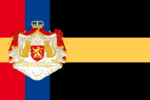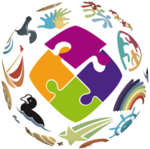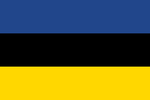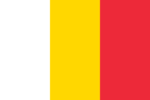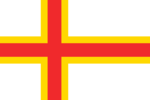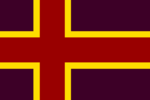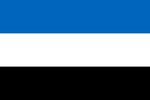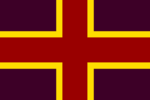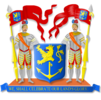Kingdom of Mahuset
This article refers to a micronation or element of micronationalism which is defunct and no longer exists. You can help make the article reflect that or ask on the talk page for further information. |
Kingdom of Mahuset Koninkrijk Mahuset Regnomia Mahuset | |
|---|---|
| Motto: Mahusetoni Vetriana | |
| Anthem: Mahusetoni Vetriana | |
 | |
| Official languages | English, Dutch and Italic Mahusetan |
| Demonym(s) | Mahusetan |
| Government | Constitutional Federal Monarchy |
• King | Emilo I |
• Prime Minister | Nuri I |
• Ruler of Matsia | XO |
| Legislature | Triumphant Parliament |
| Establishment | 14th of July, 2012 / M0.00 |
| Population | |
• Census | 154 |
| Currency | Mahusetan Vetriana-Gulda |
| Time zone | (GMT+22m) |
Website www.mahuset.com | |
Mahuset, officially the United Kingdom of Greater Mahuset and the Mahusetan Realm was a self-declared independent nation-state, commonly referred to as a micronation by external observers, which had claims in Europe, Antarctica, and Asia. It was governed as a federation, with various systems in its numerous states. Mærtan Ihuset (Poseidon Ihuset), Radon and Cherrystan (Matsia) together made up mainland Mahuset, in Northwestern Europe.
Mahuset was a federal state and a constitutional monarchy with a king, Emilo I and was administered by a parliament known as the Triumphant Parliament. While the laws of the states were subordinate to federal law, the federal government did not have any regulations on the means for administering states and as such the states all had their own unique system of governance. It was regarded as a minor inter-micronational diplomatic power and a leading cultural and political power in Europe.
Mahuset, with a mixed market capitalist economy, ranked as having a high level of income equality. It was frequently ranked as a happy and lowly corrupt nation. The national language, Italic Mahusetan, was closely related to Italian, Dutch, Radonic, and English. Mahuset was the only surviving successor to the defunct Mahusetan predecessors which are the Kingdom of Ihuset, the Kingdom of Matsia, the Kingdom of Radon and all Cookielandic and Kittylandic States. Mahuset itself is now succeeded by several micronations, those being Dolmenia, Slin, Itazaria, Danland and Krasota.
Mahuset was a "Fifth World" micronation with a score of 12 under the Boodlesmythe-Tallini System and scored 4.2 on the Categoric-Gradial/Linden's (Revised) System.
Etymology
Although the exact reason for the name Mahuset is unknown, it is thought to be a portmanteau of Matsia and Ihuset.
History
Prehistory
The earliest mention of Alkmaar, where most of Mahuset is based, leis in a 10th-century document. As the village grew into a town, it was granted city rights in 1254. The oldest part of Alkmaar lies on an ancient sand bank that afforded some protection from the sea during medieval times. Even so, it is only a couple of metres above the surrounding region, which consists of some of the oldest polders in existence.

In 1573 the city successfully withstood a siege by Spanish forces under the leadership of Fernando Álvarez de Toledo, 3rd Duke of Alba. It was a turning point in the Eighty Years War and gave rise to the expression Bij Alkmaar begint de victorie ("Victory begins at Alkmaar"). The event is still celebrated every year in both Alkmaar and Mahuset on the 8th of October, the day the siege ended. In 1799, during the French revolutionary wars, an Anglo-Russian expeditionary force captured the city but was ultimately defeated in the Battle of Castricum. The French victory was commemorated on the Arc de Triomphe in Paris.
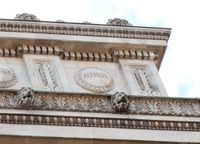
The North Holland Canal, opened in 1824, was dug through Alkmaar. In 1865 and 1867 the railways between Alkmaar and Den Helder and between Alkmaar and Haarlem were built respectively.
In the second half of the 20th century, Alkmaar expanded quickly with the development of new neighbourhoods. On October 1, 1972, the town of Oudorp and the southern portions of Koedijk and Sint Pancras were added to the municipality of Alkmaar.
Burgemeester de Wilde School


The Burgemeester de Wilde School, a Dutch primary school, was the school where Emiel, Nuri, Matthies, Ewout and various other people who were influential in Mahuset's history have had their early education. The Burgemeester de Wilde School was founded in 1976 by Henk de Wilde, the mayor of Schagen and member of the Dutch Labour Party. The school is a cluster 2 school, meaning that it is a school for children with issues in communication. The school's main location, the Meerkoet was founded in 1976, in Schagen. The Pulletje, another location of the school, was founded in 1980, in Hoorn. The Kievietlaan, another location of the school, was founded in 2006 and closed in 2013. Alkmaar, another location of the school, was founded in 2008. The Hoep, the replacement for the Kievietlaan, was founded in 2013, in Schagen. The Hendrik Mol was founded as a high school but it separated later.
-
First logo of the Burgemeester de Wilde School -
Second logo of the Burgemeester de Wilde School -
Third logo of the Burgemeester de Wilde School
Pre-Ihuset
Mahuset began as a fictional nation within a fictional world in 2007. It was called Emiel's World and was an Empire, Emiel was the emperor and was referred to as Cool Emiel. It was not serious at all but there were still plans to revive it within Ihuset. If it was never founded, Emiel never would have come in contact with politics. Emiel's World had a dialect of Dutch known as Emilan, which was what developed into Mærtan, another dialect which had severe effects on Mahusetan history.
Kingdom of Ihuset
Emiel went on Wikipedia around April 2012 and looked at pages of ministates like the Vatican City, Monaco and San Marino and eventually found out about the Principality of Sealand. He did more research into this and found info on the Republic of Molossia. He got inspired by these two micronations and wanted to make his own micronation. Ihuset was then founded with his research as inspiration, it is said it was founded to give him the "feeling of autonomy" which he lacked at the time. Emiel made a page on MicroWikia and got "unofficially" involved in the many cyberwars going around on MicroWikia at the time. This was the start of Mahusetan diplomacy as it got into contact with many micronations, good or bad, like New Canada and Domus. It got welcomed by Flatland almost immediately and it got invited into the Grand Intermicronational Alliance by a representative of Northumbria-Montebourg. This was the first time Ihuset ever did any act of diplomacy and it joined. It left because it didn't want to join the wars it was entitled to do.
Early Kingdom of Mahuset
After Emiel founded Ihuset, the other children at the Burgemeester de Wilde school were inspired to create micronations themselves, being Matsia and Radon. Mahuset was originally founded as an unification of Matsia and Ihuset, but Radon quickly joined, the original name was the United Nations of Mahuset but it had quickly changed to the Royal United Nations of Mahuset. It was mainly inspired by Ancient Rome and the County of Holland. Mahuset quickly gained diplomacy and a great significance within the MicroWikia community. Many conflicts at MicroWikia had various Mahusetan officials in them, including the conflict against Brandon Rhea and Wikia, the split which let to the establishment of Micropedia and all the the splits which let into all future versions of Micropedia. Vetria had established Diplomatic Relations with Mahuset during this era.
Late Kingdom of Mahuset
Around November 2012, the Royal United Nations of Mahuset transformed into the Kingdom of Mahuset. The first stable government was established by Emiel during this era, having a democracy and various political powers. At this time the Eniakist ideology was created by Emiel, which would change Mahuset for the rest of its live and it gained a great significance. When the "Eniakisation" of Mahuset started, Mahuset started to reach a higher HDI fairly quickly. The rapid expansion of Eniakism had been deemed similar to the Rise of Communism by various people. The Eniak Party ruled and Mahuset became a one party state. During the era of the one party state, Mahuset established the Eniak Government which would rule the kingdom until it collapsed. The government was fairly well developed compared to older governments having political parties, a functional system of division, ministries and state owned companies. Eventually Radon and Matsia rejoined Mahuset and the Triumphant era started, which ended with the collapse of the kingdom.
Eniak Era
2013 marked the transition of the Royal United States of Mahuset into the Kingdom of Mahuset, having both Eniakism and Illuminism as its policies. This was marked with protests of the intermicronational community, with Hasanistan and Akharnes comparing the rise of eniakism to the rise of communism. Nevertheless, Mahusetans supported and build upon the Eniakist ideology.
Empire of Constantidium
Mahuset had been a part of the Empire of Constantidium, which was founded by several states in the Dutch micronational sector, due to disagreements this quickly failed however. Its member states were the Kingdom of Mahuset, Derskov-Viadalvia, Hoogwaard, Arnhem, Snežanopol, Timbain and Kinhu. While it was shortly successful, it really only existed to form a "block" against the Ashukov Federation within the now dead micronations.wiki community.
Collapse of the kingdom
Even though the government was stable and well structured, the three states, Radon, Matsia and Poseidon-Ihuset got into various disputes, especially about the new acts in the constitution and conflicting ideals. This happened about three times, the last one resulting in the collapse of Mahuset, when Poseidon-Ihuset left and declared itself defunct as result of the aforementioned disputes.
Establishment of Krasota, and the proposal of the Royal Union of Mahuset
Krasota was founded as a union of Matsia and Radon, yet later joined the Royal Union of Mahuset. It later wanted to refound Mahuset, because according to its representatives, "it was just better". This was welcomed by Emiel, who was at that moment exclusively working on Slin. Emiel agreed to the Krasotan proposal, and helped with the establishment of the Royal Union of Mahuset. The Royal Union of Mahuset, which was now founded, was quick to collapse because of further disputes between Nuri and Emiel, which also indirectly caused the collapse of Krasota.
Establisment of the Empire of Alkmaar
Emiel established the Empire of Alkmaar, quickly becoming the ruling power in the former states of Alkmaar, Jefferson and some lands around these states. While the Empire of Alkmaar quickly led to a more stable government, this gain was quickly overturned by inactivity, which eventually led to the death of Alkmaar.
Year of no Mahuset
2015 was a year of little Mahusetan activity as the prominent citizens were all focusing on their own personal project; XO having no state in the later months of 2015, Emiel focusing on developing on Slin and Nuri being busy on reforming Radon, which partook in several events within the Micronationals community.
Establishment of the Confederation of Mahuset
On the 8th of January 2016, Emiel Hardy, Nuri van Dijk and XO established the Confederation of Mahuest, claiming the former territories of Matsia, Alkmaar, Geestmerambacht, Nooorderhout and Ihuset. A constitution was created based upon the former constitution formerly used by the previous Kingdom of Mahuset, which has elements of the Dutch and American constitution in it, was drafted and signed by Emiel Hardy, therefore establishing the Confederation.
The now established Lazian Chamber was quick to introduce various decisions, including but not limited to the Flag and Coat of Arms, turning down recognition of Kosovo, and establishing relations with Radon and the United Islands.
-
First proposal by Emiel Hardy, and first proposal overall. -
Second proposal by Emiel Hardy, and second proposal overall. -
Third proposal by Emiel Hardy, and second proposal overall. Now flag of Noorderhout. -
First proposal by XO, and fourth proposal overall. Closely resembles current flag. -
Fourth proposal by Emiel Hardy, and fifth proposal overall. Now flag of Lazia -
Second proposal by XO, and sixth proposal overall. This flag is the current flag of Mahuset.
Government

Mahuset was governed under a mix of a pseudo-federal absolute and constitutional monarchy, with each federal state responsible for governing their own state affairs. The federal government was known as the Eniak Government and all members of said government were responsible for making final decisions for all the federal governments.
The Monarch was the head of state, the Monarch was also allowed appoint any officials directly with consent from the people. The Monarch was counselled on the matters of state by the Prime Minister and the Mahusetan Triumvirate. The Monarch was both an absolute and a constitutional monarch as the Monarch was subjected into the laws of the Kingdom, but was also allowed to do some independent decisions without consent. Constantly, the rule was mostly ignored and the Monarch was more of an absolute Monarch hence why the presence of the Monarch was important to the activity and health of the Kingdom.
The Prime Minister is the head of the government, who was appointed by the Monarch. The Prime Minister had the same power as the Monarch, and unlike the Monarch, everything must be approved by the Triumvirate. The Prime Minister was also allowed to enact his/her own laws, with direct approval of the Monarch and the Triumvirate. The Leader of Matsia acted as the deputy of the Prime Minister in any cases that the Prime Minister may become incapacitated, out of contact or resignation.
The Eniak Government served as the parliament of the Kingdom and the parliament for all the federal states, and its members wee directly appointed by the Monarch himself. Acts passed by the Monarch are usually done in the name of the Triumvirate and are known as an Act of the Parliament.
Triumviri
| Mahusetan Triumviri | ||||||||||||
| Emiel Sebastiaan Hardy King of Mahuset |
Nuri van Dijk Prime Minister of Mahuset |
XO Ruler of Matsia | ||||||||||
|---|---|---|---|---|---|---|---|---|---|---|---|---|

|

|

| ||||||||||
Political Parties
| Name | Logo | Founded | Ideology | Position | Seats | Leader |
|---|---|---|---|---|---|---|
| MER | 
|
2012 | Eniakism | Centre | 3 / 9
|
Emilo I |
| Kerindy Party | 2014 | Socialism | Far left | 1 / 9
|
XO | |
| Party for Freedom of Speech | 
|
2012 | Populism | Far right | 1 / 9
|
Karin Kesselaar |
| Simplicity Party | 2013 | Simplism | Far Left | 2 / 9
|
Stendert van Amersfoort | |
| Independent | None | 2013 | Independent | Various | 2 / 9
|
None |
Prime Minister
Foreign Relations
Mahuset had an established structure of foreign relations, and as such, it was a member of several organisations such as the Grand Intermicronational Alliance, World Union, Association of Prolific Micronations, Micronational Broadcasting Union, Organisation for Unity between Mahuset and Carpathia and the United Empire of Mouzilo and Mahuset.
The Monarch and the Prime Minister had primary roles in setting a foreign policy for Mahuset. Mahuset had strong ties with nations such as the Republic of Vetria, Confederate State of Derskov-Viadalvia, Federal Republic of Hasanistan, Second Empire of Slin and many more.
Diplomatic Relations
![]() Confederate States of Derskov-Viadalvia
Confederate States of Derskov-Viadalvia
Mutual Recognition
Informal Relations/Friendship
Internal Affairs
Before Mahuset became a federal Kingdom, it was governed directly by the Monarch, with cities acting as subdivisions in the Kingdom and each having their own appointed Mayor. Later marked the period of Mahuset being headed by a federal Monarch, on which the Monarch was first among equals. Each federal state was responsible for governing their own, but was sometimes subjected to federal laws. Federal states were allowed to have their own elections and elected heads of government. Laws of the federal states are enacted in the Eniak Government as it is the united parliament of all the states and each state has a right to propose any law that is to specific for their state only and not to the entire Kingdom, unless it contradicts a federal law.
Economy
Mahuset has a mixed-market capitalist economy. Most, if not all, Mahusetans are lower-middle class to upper-middle class. There is very little income inequality. Major private Mahusetan businesses include Oxocero Holdings, PP Holdings, Post le Mahusetoni and MahusetoniTV.
Currency
Mahuset has had various currencies over its lifetime. The unit of currency from the Kingdom of Ihuset's founding, and until the founding of the United Nations of Mahuset, was the Husetan Pound, and was pegged to one euro. The unit of currency used from joining the World Union until said union's death was the InterSol and was pegged to 0,13 euro. The unit of currency used from the end of the World Union to the start of the Eniak Era was the Mahusetan Kroner-Guilder, and was pegged to 0,50 euro. The unit of currency used from Radon and Matsia joining until the death of Mahuset was the Mahusetan Vetriana-Gulda and was pegged to 0,45 euro.
Development

Development on an immense scale occurred during this period, anticipating similar advancements in other micronations. In 2013, there were ten different corporations with a total capital of mvg700. At the end of the Eniak Era in 2014, Mahuset had 12 corporations representing an annual rate of increase of 16.67% over the number in 2013, and with a total capital of approximately mvg947 (which represents an annual growth rate in value of 15.52% from 2013 to 2014). The "countryside echoed with a beep as technology was created at the most furious pace of 2013; indeed, technology in 2013 was the second greatest in absolute terms in Mahuset's entire history. Only a few nations in the entire world created more technology in 2013 than Mahuset." The first piece of software, with only two functions, was created in early 2013 at a time when many other micronations produced no software. By 2013, there were four pieces of software, and by the end of Mahuset in 2012 this had grown to six with another four pieces of software under construction making it the country with "the biggest tech-tat scene".
Companies were established throughout the Kingdom in 2013, allowing Mahuset's cities to be modernized and "receive the benefits of the technological industry. Mahuset was entering the modern world." It was the first and only state within its community to have a corporation, the second to have five and one of the pioneers in the establishment of a postal service. In addition to the foregoing improvements to infrastructure, it was also the first nation within its community to adopt a basic effective civil law (in 2013) and the first within its community to establish a digital contact line connecting its mainland to its further away provinces in 2013. The first documented vehicled was purchased in 2014 in Mærtan Ihuset. By 2014, there were four different contact lines connecting the country's capital to distant Mahuset provinces such as Radon and even linking to other countries within its community such as Derskov-Viadalvia and Hasanistan.
Largest Companies
| Rank | Name | Headquarters |
|---|---|---|
| 1. | Oxocero Holdings | Alkmaar |
| 2. | PP Holdings | Lareanit, Northern Avernoi |
| 3. | Post le Mahusetoni | Alkmaar |
| 4. | MahusetoniTV | Alkmaar |
| 5. | Reedani Winkcentaur | Baedio |
| 6. | Respel | Fraterio |
| 7. | Fraternis Tdown | Fraterio |
| 8. | Central Television Broadcasting | Lareanit, Northern Avernoi |
Geography
Mahuset's claimed land consists of nine separate portions of land in Europe, Antarctica and Asia, divided into Radon, Cherrystan (Dutch Matsia), Cambois Beach (British Matsia), Islo Keri (British Matsia), Poseidon (British Poseidon-Ihuset), Brightonshire (British Poseidon-Ihuset), Mærtan Ihuset (Dutch Poseidon-Ihuset), Kanifa (Antarctic Jefferson and Columbus), Matias and Sopha (Mediterannean Jefferson and Columbus) and Mahusetan Hasanistan (Central Asian Jefferson and Columbus). Originally, the Kingdom's claimed land consisted only of Mærtan Ihuset, which was enclaved by the Municipality of Alkmaar in the Netherlands, in the heart of the fields and swamps of Noord-Holland. Laying in the middle of the former swamplands of Noord-Holland, Mærtan Ihuset, together with Radon and Cherrystan (Dutch Matsia), made up mainland Mahuset. In Mahusetan, this sort of geographical area was known as a paltadelo, literally meaning swamplot. The particular area of "paltadelo" in which Mærtan Ihuset was founded is nowadays known as Burgemeester de Wildeland, and it's the place where all former nations of the Vetrisphere were established or can trace their origin to, including Mærtan Ihuset, Radon and Matsia. Mærtan Ihuset, together with Radon and Cherrystan (Dutch Matsia) comprised of 1.124 km2 of claimed and controlled land.
Laying in the cold icy plains of Antarctica, United Kanifa made up the Mahusetan Antarctic colony. In Mahusetan this sort of geographical area was known as a poldes. The particular area of "poldes" in which United Kanifa was claimed as per King Emiel's plans for expansion outside of mainland Mahuset. United Kanifa comprised of 250903 km2 of claimed and controlled land.
Laying in the mountains of the Hasanistan, Starnia made up the Mahusetan Hasani colony. In Mahusetan this sort of geographical area was known as a montolo, literally meaning mountain lot. The particular area of "montolo" in which Starnia lays was claimed as per King Emiel's plans for expansion outside of mainland Mahuset. Starnia comprised of 4390m2 of claimed and controlled land.
Laying in the middle of the Adriatic Sea, Matias and Sopha made up the Mahusetan Adriatic colony. In Mahusetan this sort of geographical area was known as a belosee, literally meaning mountain of the sea. The particular area of "belosee" in which Matias and Sopha lays was claimed as per King Emiel's plans for expansion outside of mainland Mahuset. Matias and Sopha comprised of 303240m2 of claimed and controlled land.
Laying in the middle of Northumberland, Islo Keri (British Matsia) and Cambois Beach (British Matsia) made up British Matsia. In Mahusetan, this sort of geographical area was known as a paltadelo, literally meaning swamplot. The particular area of "paltadelo" in which British Matsia lays made up the Matsian mainland. British Matsia comprised of 5.047 km2 of claimed and controlled land.
Climate
| Climate data for the Mahusetan Mainland | |||||||||||||
|---|---|---|---|---|---|---|---|---|---|---|---|---|---|
| Month | Jan | Feb | Mar | Apr | May | Jun | Jul | Aug | Sep | Oct | Nov | Dec | Year |
| Record high °C (°F) | 17.2 (63) |
20.4 (68.7) |
25.6 (78.1) |
32.2 (90) |
35.6 (96.1) |
38.4 (101.1) |
38.2 (100.8) |
38.6 (101.5) |
35.2 (95.4) |
30.1 (86.2) |
22.0 (71.6) |
17.8 (64) |
38.6 (101.5) |
| Average high °C (°F) | 5.5 (41.9) |
5.5 (41.9) |
8.3 (46.9) |
11.7 (53.1) |
15.4 (59.7) |
18 (64) |
20.3 (68.5) |
20.6 (69.1) |
17.9 (64.2) |
14.0 (57.2) |
9.7 (49.5) |
6.4 (43.5) |
12.8 (55) |
| Daily mean °C (°F) | 3.5 (38.3) |
3.3 (37.9) |
5.6 (42.1) |
8.4 (47.1) |
12 (54) |
14.7 (58.5) |
17.1 (62.8) |
17.4 (63.3) |
15 (59) |
11.4 (52.5) |
7.5 (45.5) |
4.4 (39.9) |
10 (50) |
| Average low °C (°F) | 1.2 (34.2) |
0.8 (33.4) |
5.6 (42.1) |
8.4 (47.1) |
8.7 (47.7) |
11.3 (52.3) |
13.8 (56.8) |
14.0 (57.2) |
11.7 (53.1) |
8.5 (47.3) |
4.9 (40.8) |
2.0 (35.6) |
7.1 (44.8) |
| Record low °C (°F) | -27.4 (-17.3) |
-26.8 (-16.2) |
-20.7 (-5.3) |
-9.4 (15.1) |
-5.4 (22.3) |
-1.2 (29.8) |
0.7 (33.3) |
1.3 (34.3) |
-3.7 (25.3) |
-8.5 (16.7) |
-14.4 (6.1) |
-22.3 (-8.1) |
−27.4 (−17.3) |
| Average Precipitation mm (inches) | 66.7 (2.626) |
45.1 (1.776) |
52.8 (2.079) |
34.2 (1.346) |
45.5 (1.791) |
54.6 (2.15) |
60.3 (2.374) |
77.3 (3.043) |
84.0 (3.307) |
96.3 (3.791) |
83.8 (3.299) |
70.2 (2.764) |
770.9 (30.35) |
| Average relative humidity (%) | 88 | 86 | 85 | 81 | 80 | 80 | 80 | 80 | 82 | 84 | 86 | 88 | 83 |
| Average rainy days (≥ 1.0 mm) | 18 | 14 | 17 | 13 | 13 | 13 | 14 | 14 | 17 | 18 | 20 | 18 | 188 |
| Sunshine hours | 64.1 | 91.2 | 134.8 | 194.2 | 235.2 | 219.0 | 228.2 | 208.2 | 148.1 | 114.2 | 63.1 | 51.1 | 1,751.4 |
| Source: [1][2] | |||||||||||||
Political Geography
Mahuset was a federation of numerous states, also called territories, who are guaranteed numerous rights outlined in the constitution. Said states had loose cooperation with each other, in what was referred to as political realms.
| Flag | Emblem | Name | Political Realm | Population | Parliamental Delegates | Head of State | Head of Government | |||||
|---|---|---|---|---|---|---|---|---|---|---|---|---|
| States | ||||||||||||

|
Principality of Radon |
100 | Nuri I | Nuri I
| ||||||||

|
State of State of Matsia |
8 | XO | XO
| ||||||||
| Districts | ||||||||||||

|
Capital District and Principality of Alkmaar-Poseidon Ihuset |
44 | Emilo I | Emilo I | Karin I | |||||||
| Territories | ||||||||||||

|
County of Jefferson and Columbus |
2 | Shady Morsi | Shady Morsi
| ||||||||
Vehicle Registration Plates
The MELP-standard were a series of vehicle registration plates issued by the Triumphant Parliament. MELP-standard
vehicle registration plates are assigned bearing the same "number" (a sequence of characters composed of letters and digits) as that shown on the vehicle's registration document. The numbering scheme used bears no relation to the place of a vehicle's registration or ownership, and numbers identify the vehicle, not its owner. Thus, if a vehicle changes ownership, the registration number remains unchanged. Two exceptions to this existed, namely vehicles owned by the Royal Family of the Kingdom of Mahuset where the last three were replaced with the letters ROY, and taxis where the first two digits were replaced with the letters TX.
Culture
The diverse culture of the Kingdom of Mahuset had been influenced by elements of many other cultures, most notably the customs and traditions of the Netherlands, where most activity of the kingdom took place. The nation could be considered a melting pot of contrasting cultural currents. The three original regions of Mahuset, Radon, Matsia and Alkmaar-Poseidon Ihuset, have counted with different cultural influences each. Late Mahusetan culture, as a whole has been greatly influenced by Dutch, and English culture as well as artificially introduced elements of other cultures, such as the Italian culture in Alkmaar-Poseidon Ihuset and Eastern Asian traditions in Radon.

Languages
Both Dutch and English were spoken natively in Mahuset. The Husetan, Matsian, and Radonic population spoke either Dutch, English, Italic Mahusetan or Radonic. Most citizens rarely spoke these languages and preferred to use their native tongues. The Government uses English as the nation's official and national language, while Italic Mahusetan was regarded as a national language and a part of the nation's cultural heritage.
The Italic Mahusetan language was developed in Mahuset, while Mahusetan (also called Pika-Mahusetoni by some older sources) was developed in Poseidon Ihuset. The closely related variant Early Radonic, as its name indicates, was developed in Radon. The Radonic language was mostly used for cultural purposes in its place of origin of Radon.
Religion
The Constitution of the Kingdom of Mahuset guaranteed freedom of religion, though the government was officially atheist. From its founding until the begin of the Eniak Era, almost the entirety of the Kingdom's population identified as atheists. As Mahuset liberalised and expanded its population at the dawn of the Eniak Era, atheism went into a small decline.
Cuisine
The Kingdom of Mahuset's cuisine was undoubtedly a mix of different cultures, having been influenced mostly by Dutch and English dishes. The country's cuisine was mostly shaped by its location in the fertile North Sea river delta of the European Plain, which gave rise to fishing, farming, and trading over sea.
Traditions
One traditional festivity in Mahuset (but also in the Netherlands) is the feast of Sint Nicolaas or Sinterklaas. It is celebrated on 4–6 December in families, especially in families with little children. Another tradition is beschuit met muisjes when people come to visit a new-born baby and his/her mother and get the beschuit met muisjes
The Kingdom of Mahuset counted a varied range of holidays, festivals and celebrations. Most Mahsuetan holidays were of either Dutch or English origin.
| Date | English name | Dutch name | Remarks |
|---|---|---|---|
| 1 January | New Year's Day | Nieuwjaar | The day before is called "Old Year's Day" and not "New Year's Eve." |
| 9 January | Prince Day | Prinsdag | Celebration of the birth of Jeroen I. |
| March/April | Good Friday | Goede Vrijdag | It is also known as Holy Friday, Great Friday, Black Friday, or Easter Friday. |
| March/April | Easter | Eerste Paasdag en Tweede Paasdag | The Mahusetans celebrate two days of Easter (on Sunday and the subsequent Monday). |
| 4 May | Remembrance of the dead | Dodenherdenking | Remembrance of the deaths in the Second World War. |
| 5 May | Liberation Day | Bevrijdingsdag | Celebration of the 1945 capitulation of German forces in World War II. |
| 29 May | Mahuset Day | Mahuset Dag | Celebration of the creation of Mahuset. |
| 26 September | King Day | Koning Dag | Celebration of the birth of Emiel I. |
| 8 October | Siege Day | Alkmaar's Ontzet | Celebration of the Dutch forces winning from the Spanish forces. |
| 4 December-6 December | Saint Nicholas | Pakjesavond | A predecessor of Santa Claus, Sinterklaas, gives presents to the children. While Saint Nicholas' name day is on 6 December, in Mahuset usually only Saint Nicholas' Eve is celebrated on the 5th of December. |
| 25th and the 26th of December | Christmas | Kerstmis | The Mahusetans celebrate two days of Christmas: Eerste Kerstdag (the first day of Christmas) and Tweede Kerstdag (Boxing day). |
